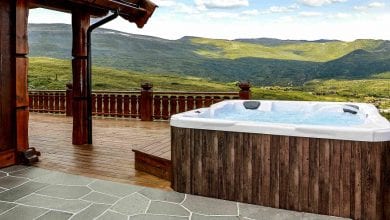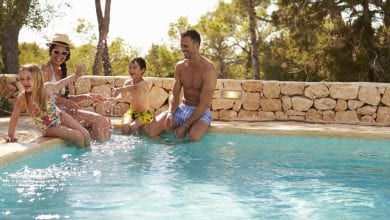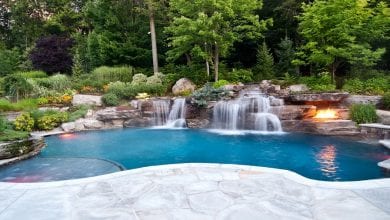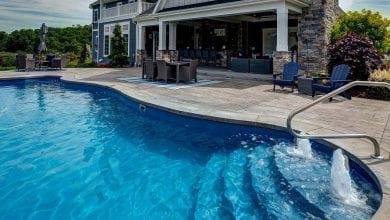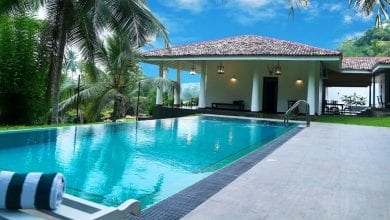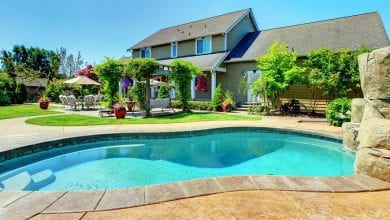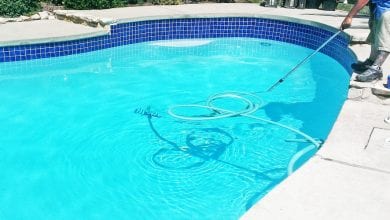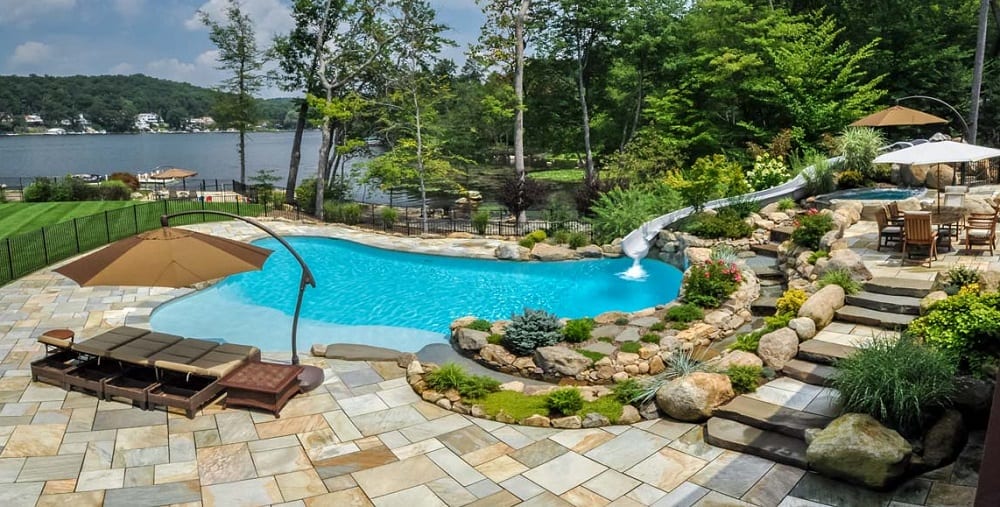
What Does CYA Mean?
In terms of pool care and maintenance, a lot of people ask what does cya mean? The short answer is that it stands for Cyanuric Acid. But what is it used for, and why? Any responsible pool owner needs to get to know the chemicals and what they can be used for which is why we are going to take an in-depth look at this useful chemical. Not only are we going to understand it better, but see when it is useful, and see if you really need to use this common stabilizer or not.
So, What Are Other Names For CYA?
Sometimes known as a pool stabilizer or pool conditioner, it is one of the most common and significant pool chemicals. Every pool cleaner service will have it in the back of their truck, ready to go, and anyone cleaning their own pool should have some to hand. It can be purchased in granular and liquid form so whichever is most convenient for you.
Why Do People Use CYA?
Because the summer months play havoc with the chemical levels. The UV rays may be welcomed by many after months of cold, but in terms of the pool’s chlorine, it is a nightmare. UV rays cause chlorine to evaporate which is why it is important to clean a pool and stay on top of the chemical levels regularly, often twice weekly in high season.
Where does cya come into this? Well, its benefit lies in how it protects chlorine levels. It helps to prevent the UV rays from evaporating chlorine so much. This will not only ensure you are putting less chlorine into the pool, but also make it safer for everyone to use.
Do What Does CYA Actually Do?
In peak summer, UV rays can evaporate over 50% of the chlorine in a pool within a couple of hours. This means that when it is being used the most, the chlorine levels are almost constantly dropping. Before too long, the water is unsafe to use and a breeding ground for bacteria and algae. Although regular maintenance will help a pool owner keep an eye on the chemical balance, it can be frustrating having to throw so much chlorine into the water every couple of days.
This is why CYA is useful. It binds to the chlorine, protecting it from the sun’s rays. However, it has a weak nitrogen bond which means it can still break from the CYA to kill bacteria and other nasties. This is why it is called a stabilizer, it helps to keep the chlorine levels under control. Without Cyanuric Acid, expect to be adding a lot of chlorine, only for it to need topping up soon after.
How Much CYA Does A Pool Need?
This depends on a few factors, with plenty who disagree on how much is necessary for different sized pools. Add too much, and there is research that suggests it becomes ineffective. If these studies are to be followed then anything above 50ppm is going to be useless. This could impact the effectiveness of the chlorine which is why it is better to stay below. Between 20ppm to 50ppm is often considered enough.
However, keeping your cya below 50ppm isn’t enough. There needs to be a balance. The free chlorine levels should be regularly tested and remain around 7.5% of the cya level. So, for 25ppm, the sanitizer should be 1.5ppm, for 50ppm it should be 3ppm.
For every 30 ppm it needs to be raised, add 4lbs per 10,000 gallons.
Do You Need To Use It Often?
Compared to other chemicals, it is not going to be used up so quickly. It will remain in the winter for some time and only an entire change of the water, excessive use, or prolonged periods of exposure to UV rays will cause it to disappear. Topping up the water, and we include rainwater in this, will also dilute the cyanuric acid.
The most you are likely to add is if it has been a long time since the pool had some TLC like for opening it for summer. It can also be a good idea to add some when winterizing the pool. Stabilized chlorine will ensure it doesn’t need to be topped up often so staying on top of the pool maintenance will mean the supply you have lasts a long time.
How To Add CYA To A Pool
Because of the strength of the acid, it is always best to wear chemical-proof gloves and protective goggles before mixing. Take a bucket and add the appropriate amount of CYA for the pool to some warm water. This makes it easier to pour it in whilst circling the pool. Such a method will allow the contents to mix properly and spread to all areas easily.
For the most part, there should be enough CYA in the stabilized chlorine should you use this to keep the water clean. Otherwise, test the water and make sure the chlorine levels aren’t falling significantly throughout the week. Remember that even with CYA in the water, the chlorine levels are still going to fall during peak summer when the UV rays are constant and strong.
If you are unsure of the levels of cya in the pool, use a test kit that will provide an accurate reading of the levels of a variety of chemicals.
Can You Have Too Much CYA In A Pool?
The short answer is yes. As we touched on earlier, if this is the case, it could be impacting the chlorine and rendering it useless. Should this be the case, it is often because the user is adding stabilized chlorine into the pool. In which case, there is already CYA in the formula so adding more may have gone too far.
Because the formula will have a list of words that seem impossible to pronounce, it can be hard to tell. However, if you notice any of the following then it already has CYA: trichloroisocyanurate or sodium or potassium dichloroisocyanurate.
What To Do With Too Much CYA In A Pool
When this is the case, there are a few things that work to reduce the level. Firstly, use chlorine that does not have cya in the formula until it reaches an acceptable level. Alternatively, you can wait it out and allow the UV rays to evaporate some of the CYA or add water to the pool to dilute it (within reason).
If the CYA content reaches a certain level it can be near impossible to remove. This is where draining the pool and refilling is the best approach. Because it stays in the water and filter like calcium deposits, it is difficult to shift.
A Word On Safety
As with any acid, there is a level of caution to be taken when adding it to your pool. Enough experts are warning against adding it to an indoor pool to make it a sensible idea to avoid adding it to these pools. Any pool that is used frequently by multiple people will want to be careful about adding CYA. This is because the chlorine needs to be able to work hard at removing and killing pathogens.
With too much CYA, the chlorine will not be as effective, which is where E.Coli and other nasties become a problem worth thinking about. It always helps to have a little CYA in a pool, especially if there are windows where the UV rays can still get to the pool.
Can You Put CYA In A Hot Tub?
Although a little might not do any harm, it is an unnecessary additive to a small volume of water. This can throw the balance off without adding a lot so for most people, it is not worth the risk. For a safe and happy hot tub, stick to using regular chemicals and check the balance of them often.
Why Does CYA Sit At The Bottom Of The Pool?
For a lot of people, throwing it in without diluting it in water will cause it to go straight to the bottom and stay there until dissolved. This is why we recommend mixing it with water then pour it evenly around the pool. Even still, this method can still result in some CYA sitting at the bottom, but that is to be expected and it will soon dissolve.
Will More CYA Result In More UV Protection?
Not at a certain point. Anything above 50 ppm is going to hurt the effectiveness of the chlorine. Essentially, adding too much will make both the CYA and the chlorine in the pool a waste.
CYA Is Not Showing On A Test Strip – Why?
This could be because the levels have gone so high that it is not showing. Anything above 100 ppm could have this effect. Alternatively, the test strip itself could be out of date, or faulty so it is best to double-check before worrying about draining the pool.
If you are worried about how much CYA there is in your pool water, take a sample to your local pool supplies store and ask them to test it. They should also give you advice on what to do next should it be too high.
CYA and Cryptosporidium
Anyone with young kids knows that fecal matter could become an issue at some point in the pool. If they have been unable to hold on for the bathroom and you are left having to deal with the aftermath, then this could be a worse problem than having to clean out a skimmer. It is a parasite that can cause illness and is common in public pools where numerous people are swimming.
Lowering the level of CYA is a good idea t this point as cryptosporidium is resistant to regular chlorine levels. Lowering CYA under 15 ppm is a good start, then adding extra chlorine before backwashing the filter, even replacing it for added safety.
How Often Should I Add CYA To A Pool?
If using a stabilized chlorine then don’t worry about adding it regularly. Once or twice a year should be sufficient. The best practice is to keep an eye on the levels and make sure the chlorine product used is doing its job and is not evaporating within a few hours in peak summer.
Should I Add CYA Directly Into The Pool?
Although there are plenty of brands out there who say it is fine to add their product directly into the water, we recommend diluting it. A 5-gallon bucket with warm water should be fine to add the relevant amount of CYA into. Then, it can either be poured whilst circling the pool or directly into the skimmer.
Remember to wear safety equipment when mixing the formula, this is still an acid and should be treated with caution. After adding it, leave it to dissolve before jumping in, adhering to the brand’s guidelines. Also, any spilled CYA around the pool should be rinsed away to protect the feet of anyone intending to get in.
Conclusion
It feels like the short answer to what does CYA mean was covered a long time ago now, but knowing the ins and outs of cyanuric acid is always useful. Thankfully, it is not something that many will have to worry about too often should as long as there is some to hand should you need to top up it on one of those once or twice a year sessions, test the levels regularly, and enjoy the pool.

